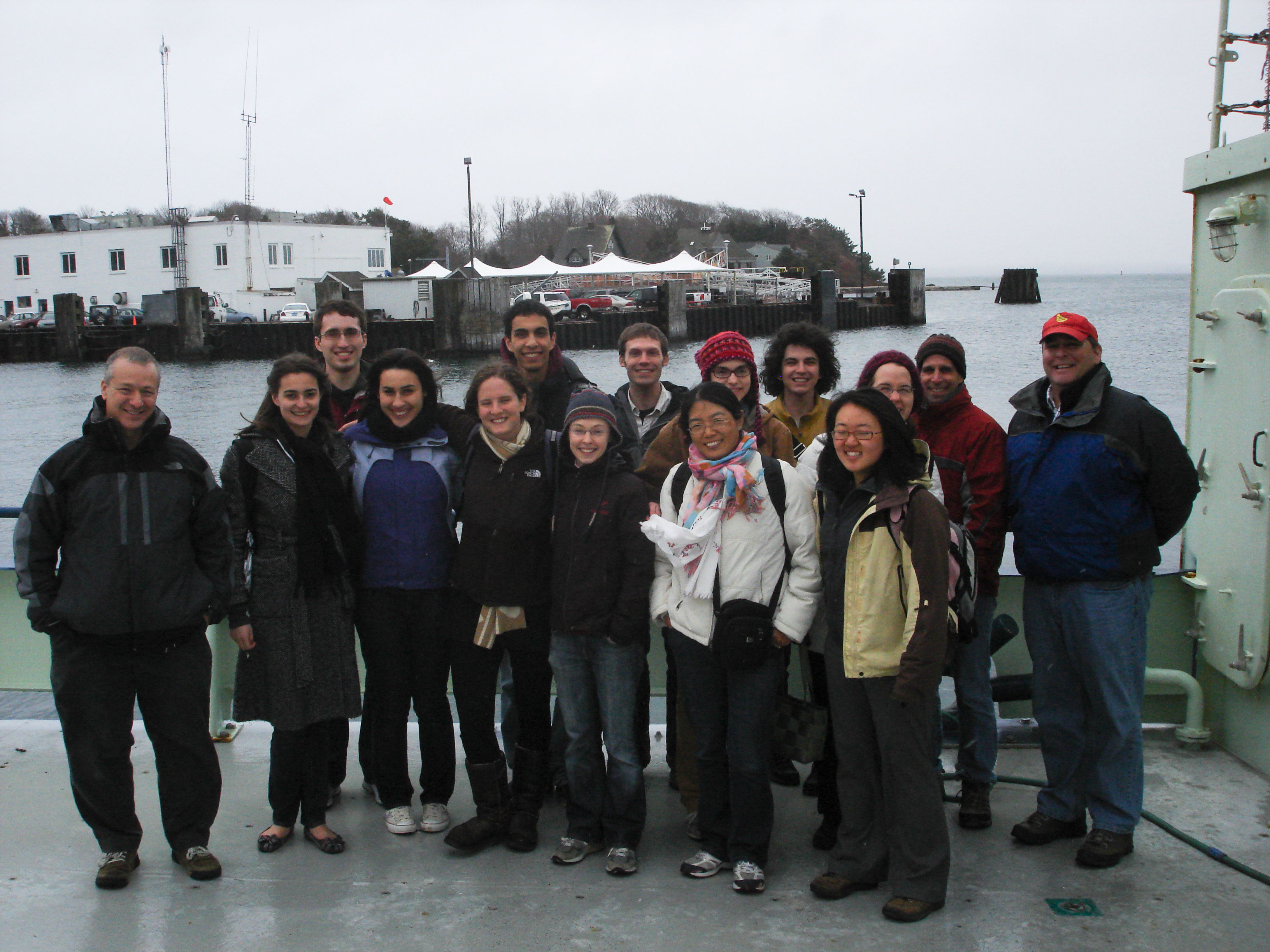 Introduction to physical oceanography and climate
Introduction to physical oceanography and climate
Course web page for EPS 131
(Spring 2010)
Field trip to Woods Hole oceanographic institution, spring 2010.
More photos from previous trips
here.
- Instructor:
- Eli
Tziperman, office hours:
Tue 2-3.
- TF:
- Nathan Arnold, narnold-at-fas.harvard.edu, tel:
617-496-6352, office: Geological Museum, 24 Oxford St, room 401.
Office Hours: TBA, Geol. Mus 401;
- Day, time:
- Monday, Thursday, 2:30-4.
- Location:
- University Museum (24 Oxford St), first floor, room
105 (Daly Seminar Rm)
- Matlab Intro Session:
- date TBA (Feb 2010) time TBA, location: TBA
- Section:
- time TBA, location: TBA.
Announcements
Last updated: May 13, 2010
The final course time will be determined during the
first two weeks of classes, to minimize conflicts with other
courses for interested students
Feel free to write or call me with any questions:
Eli Tziperman; eli AT eps.harvard.edu
Office hours: call/ write.
Field trip to the Woods Hole Oceanographic Institution (WHOI):
(DATE TBA) 2010; We'll be leaving Cambridge very early in the morning,
back in the late afternoon. Our Host will be Dr. Bob Pickart; last
time we visited to the R/V
Atlantis
and the submersible
Alvin,
plus toured the labs of WHOI;
photos;
The 2008 movie competition:
here;
The 2008 zeta vs xi competition:
here;
Main ones:
- (Kn) J. A. Knauss, introduction to physical
oceanography, 2nd edition, 1996, Prentice Hall, Upper Saddle River,
New Jersey.
Also useful:
- (St) Robert H. Stewart, on-line physical oceanography
book
- On-line version of 'Regional
oceanography'
- (OU) The open university team, ocean circulation, 2nd
ed, 2002.
- (OU-W) The open university team, waves, tides and
shallow water processes, 2nd ed, 2002.
- (Ku) Kundo P.K. and Cohen I.M., Fluid mechanics. 2nd
edition 2002.
This course will cover observations and the understanding of ocean
phenomena from local surface beach waves to the effects of the oceans
on global climate. We will discuss ocean waves, the Coriolis force
and ocean currents, the large scale temperature and salinity
distributions and more. As part of the ocean's role in climate we
will cover the wind-driven circulation and the Gulf stream, the
thermohaline circulation and the potential instability of Europe's
climate due to global warming, El Nino events in the equatorial
Pacific ocean, and more. The basic fluid dynamics equations will be
gradually introduced. A field trip to the Woods Hole Oceanographic
Institution on Cape Code will be held during the course, which will be
an opportunity to learn about practical aspects of sea-going
oceanography as well.
The students will be introduced to the Matlab software for scientific
computation and graphics, which will be used for some of the homework
assignments.
Prerequisite: Mathematics/ Applied Mathematics 21, Physics 15/ 11, or
equivalents, or permission of instructor.
Detailed lecture
notes,
other supporting
material.
- Outline and motivation
- Temperature and salinity
downloads;
- Horizontal circulation I: currents, Coriolis force
downloads;
- Waves and oscillations I: basics
downloads;
- Sea-going physical oceanography Finally, the real
stuff. Two lectures by Dr. Bob
Pickart
from the Woods Hole Oceanographic
Institution, and a field trip to Woods
Hole.
- Friction moving icebergs and feeding the fish
downloads;
- The thermohaline circulation
downloads;
- Horizontal circulation II: Gulf Stream and other western
boundary currents
downloads;
- El Nino
downloads
- Abrupt climate change
downloads;
- Some fluid dynamics fundamentals
downloads;
- Waves and oscillations II: deep ocean waves and waves
affected by the Coriolis force
downloads;
- Misc Advanced topics (time permitting);
Beginning texts:
- G. L. Pickard and W. J. Emery, Descriptive Physical Oceanography
- An Introduction, Butterworth Heinemann, 1990,
- Stephen Pond and George L. Pickard, Introductory dynamical
Oceanography, 3rd edition, Butterworth-Heinemann, 1993,
Intermediate texts:
- Philander, S. G. H., El Nino, La Nina, and the Southern
Oscillation., Academic Press, 1990,
- Benoit Cushman-Roisin, Introduction to geophysical fluid
dynamics, Prentice-Hall, 1995,
Advanced texts:
- Pedlosky, J., 1987, Geophysical Fluid Dynamics., 2nd edition,
Springer-Verlag
- Pedlosky, J., 1996, ocean circulation theory, Springer-Verlag,
Berlin-Heidelberg-New York.
- Pedlosky, J., 2003, waves in the ocean and atmosphere.,
Springer-Verlag, Berlin-Heidelberg-New York.
- Gill, A. E, 1982, Atmosphere-ocean dynamics, Academic Press,
London
Semi-weekly homework will be given throughout the course. The best
90% of the homework will constitute 40% of the final grade. Each
student will be invited to present a brief informal description of
some aspects of the ocean circulation and its role in climate and
possibly do a class presentation of a fluid experiment (20%), see
details
here
for a list of possible subjects. The final exam may be a take home
(40%).
 Introduction to physical oceanography and climate
Introduction to physical oceanography and climate
 Introduction to physical oceanography and climate
Introduction to physical oceanography and climate
